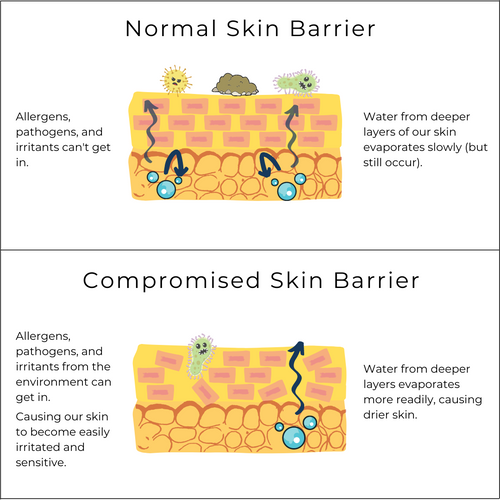All You Want To Know About The Skin Barrier
Published On: Friday, 4 June 2021
If you have heard the term Skin Barrier before but not quite sure what it is, you have come to the right place.
If you have sensitive skin that are prone to outbreak, redness, flushing, itchy, and stinging sensation, there is a chance your skin barrier maybe compromised (but not necessarily always the case).
Fortunately, with the right care and attention, you can nurse your skin back to health.
In this article we will discuss:
- What is the skin barrier actually?
- Why is a healthy skin barrier important?
- What could disrupt the skin barrier function?
- How to maintain a healthy skin barrier?
- How to repair a damaged skin barrier?
Want to hear from the expert?
We interviewed Dr Anna Chacon, she is a board-certified dermatologist from Miami, Florida. Watch the video to find out what she got to say about the skin barrier.
What Is The Skin Barrier Actually?

To put it simply, the term Skin Barrier typically refers to the outermost layer of our skin, the stratum corneum.
The skin itself has 3 main layers: the outer layer (epidermis), the inner layer (dermis), and subcutaneous fat layer (hypodermis, not shown in the picture).
The epidermis itself consists of 4-5 sublayers, and the outermost layer of the epidermis is the stratum corneum.
Zooming in to the stratum corneum, we can see that it comprises of corneocytes (which is a thickened dead skin cells) that are surrounded by lipids, arranged in a brick and mortar structure.
The corneocytes are responsible for protection against chemical and mechanical injury, with the lipid matrix providing the essential component of the water barrier.

Image extracted from: Yang, Gabsik, et al. "Skin barrier abnormalities and immune dysfunction in atopic dermatitis." International journal of molecular sciences 21.8 (2020): 2867.
What Is a Healthy Skin Barrier Important?
The skin barrier (stratum corneum) is often referred to as the dead skin layer because the skin cells in this layer is not biologically active. But that does not mean the layer has no function.
The skin barrier plays an important role in:
1. Maintaining the thermal regulation of our body
2. Keeping our skin hydrated by minimizing Transepidermal Water Loss (TEWL);
3. As well as protecting us from pathogens and allergens from outside as it acts as a protective barrier between us and the environment1.
Dry and sensitive skin that are prone to outbreak, redness, flushing, itchy, and tingling sensation are common signs of compromised skin barrier2.
But that does not mean that it is always the case. Dry skin and sensitive skin could also be caused by genetics.

What Could Disrupt The Skin Barrier?
There are many factors that could contribute to a disrupted skin barrier and often it is hard to single out one.
One potential culprit is the prolonged use of harsh facial cleanser.
It might sound counterintuitive, but washing face is one of the harshest steps in our routine. This is because most cleansers available today use surfactants as the main cleansing ingredient.
Surfactants have interesting chemical properties that make it so good in cleansing. At the "head" part of the compound, it is hydrophilic, which means it likes and attracted to water. At the "tail" part, it is lipophilic, which is the opposite of hydrophilic and means it likes and attracted to oils.
Because of this property, surfactants group together to form micelles when they are in the water. These micelles are what allows dirt and grimes to be lifted off from the skin and get carried away by water.
Interested to read more about surfactants and their impact to our skin? Read more here.

However, this property also gives surfactants the ability to strip your skin's natural oils and disrupt the skin barrier structure because the skin barrier is primarily made of proteins, lipids (fats, oils, and waxes), and water. These lipids are susceptible to be removed by surfactants.
Harsh surfactants such as the Sodium Lauryl Sulfate (SLS) can strip the skin's natural oil excessively and dry out the skin. It is also known to be mildly irritating and damaging to the skin barrier3.
Other factors that could contribute to a disrupted skin barrier are:
1. Washing your face too often.
2. Overuse of skin care products (especially over-exfoliating or using actives that are too strong).
3. Prolonged UV exposure.
4. Frequent contact with allergens.
5. Genetic.

How Can I Maintain a Healthy Skin Barrier or Repair a Damaged Barrier?
As with many things in life, we believe the key in maintaining a healthy skin barrier is through balance.
Skin care products can bring many benefits to our skin, but too much of a good thing can disrupt the skin balance, as well as too little of it.
If you are an active user of skin care products, it is a good idea to give your skin a break occasionally to give it time to recover.
How to give your skin a break? Simply go back to the basics:
1. Clean with a gentle facial cleanser to avoid stripping the skin's natural oils excessively;
2. Apply a moisturizer to keep your skin hydrated, especially if you have dry skin;
3. Apply sunscreen to protect your skin from the damaging impact of UV rays.
4. Maintain this basic routine for 2-4 weeks. Your skin naturally renew itself and it takes ~28 days to complete a cycle4.
If you have never ventured beyond face wash, start by adopting the basics before trying other products.
Listen to your skin closely during this period, you will get a clearer picture of what your skin's actual need because you are not using other products that mask your problem (or potentially create a new problem).
When you are ready to reintroduce some actives back to your routine, try to keep it simple and targeted for your specific need. You don't have to use more products than you need just for the sake of using it.
Tips #1: Barrier-friendly way to wash your face
As we discussed above, washing your face is one of the harshest steps in your routine because of how surfactants work.
Fortunately, there are many types of surfactants and some are milder than the other. Cleanser formulation is also an important factor in contributing to the mildness of a cleanser5.
We would recommend you use a mild facial cleanser regardless of your skin type.
Not sure how to choose a mild facial cleanser? Read our guide here.
Generally, you don't want the squeaky clean after-feel because it means the skin's natural oils are stripped off excessively, which could lead to oilier skin (for oily skin type) and damaged skin barrier, which in turn could lead to dry and prone to outbreak skin.
Try not to wash your face too often (~more than 2x a day) if possible. Washing once in the morning and once at night is sufficient for most people. If you have to clean your face midday because you sweat heavily, apply a moisturizer afterward.
More people now wash their face only with water in the morning and reported healthier and better-looking skin. However, this may not be for everyone, especially if you have very oily skin and live in hot and humid climate. Nevertheless, you can also give it a try and see if it works for you.


Tips #2: Apply a moisturizer to keep your skin hydrated
Moisturizer is important because it replenish moisture back to your skin (with water and humectant) and keep it hydrated by forming a layer to prevent TEWL (with emollients / occlusives).
Maintaining a well hydrated skin is important because moisture plays an important role in the skin renewal process, which in turn is an important factor in supporting a healthy skin barrier. Consequently, the lack of moisture in our skin could disrupt the renewal process and lead to disrupted skin barrier function6.
Applying moisturizer right after washing your face is the best because you can trap the water soaked by the skin before it evaporates. Also, drink enough water throughout the day.
Very oily skin type may be able to skip the moisturizer because our sebum is a natural emollient and occlusives. But, don't assume that you don't need a moisturizer just because you have oily skin because it can still be dehydrated (yes oily-dehydrated skin is a thing). Listen to your skin closely if you choose to skip the moisturizer.
Tips #3: Help your skin barrier to heal faster by applying the right moisturizer
Our skin barrier can indeed heal itself if you give it time to recover, as we have discussed above.
But, you can also help it to recover faster. Some clinical studies have found that moisturizers that contain skin-identical lipids such as ceramides, cholesterols, and fatty acids, in a particular ratio, could help to accelerate the skin barrier repair7.
(Our Barrier Defender is one option for such moisturizer)
Other ingredients that can help assist skin barrier repair are niacinamide, glycerin, urea, and panthenol 8,9.


Tips #4: Protect yourself from damaging UV rays
You are probably aware that prolonged exposure to UV light is harmful to human.
UVC is the most damaging but all of it is blocked by the atmosphere. UVB is known to be one of the leading causes of skin cancer and could cause delayed burn to the skin. UVA cause tanning and burn, it is known to be the leading cause of premature skin aging.
What is less known is that prolonged UV exposure damage the skin barrier, causing changes in the lipids structure, disrupt skin renewal cycle, increase TEWL, and decrease skin hydration10.
The best way to protect yourself from UV is avoidance. Staying indoor is the best, but of course eventually you will have to get outside.
If you do go outside in the afternoon (peak UV is usually between 10am - 4pm but it depends on the location and season), do wear sunscreen. Physical protection such as hats, long sleeves, and umbrellas is also helpful.
If you are going outside for an extended period, you would want to wear the broad spectrum SPF50 sunscreen and reapply regularly every few hours (UV filters tend to breakdown after few hours of UV exposure).
If you stay mostly indoor and not seated near the window, you should be fine even if you skip the sunscreen. But if you are seated near the window, wearing sunscreen is still recommended because UVA is not blocked by windows (UVB do get blocked).
Something To Get You Started
If you are looking for a mild facial cleanser and a lightweight, non-greasy moisturizer to get you started, check out our Gentler Cleanser and Barrier Defender.

Gentler Cleanser
Our Gentler Cleanser is formulated with a blend of amino acid-based surfactants to clean daily grimes without stripping the skin's natural oils excessively. It is also rich in moisturizing ingredients to replenish moisture back to your skin and protect the skin's barrier.

Barrier Defender
Our Barrier Defender is formulated with a blend of skin-identical lipids (ceramides, cholesterols, and fatty acids) in a 3:1:1 ratio to help with skin barrier repair. It also contains Jojoba oils and Rosehip oils that are rich in linoleic acid to help repair and strengthen the skin's barrier.
Shop Barrier DefenderSources:
- Del Rosso, J. Q., & Levin, J. (2011). The clinical relevance of maintaining the functional integrity of the stratum corneum in both healthy and disease-affected skin. The Journal of clinical and aesthetic dermatology, 4(9), 22.
- Baumann, L. S., & Baumann, L. (2009). Cosmetic dermatology 2nd edition. McGraw-Hill Professional Publishing.
- Ananthapadmanabhan, K. P., Yang, L., Vincent, C., Tsaur, L., Vetro, K., Foy, V., ... & Subramanian, V. (2009). A novel technology in mild and moisturizing cleansing liquids. Quadrant, 22(6), 307-316.
- Baumann, L. S., & Baumann, L. (2009). Cosmetic dermatology 2nd edition. McGraw-Hill Professional Publishing.
- Walters, R. M., Mao, G., Gunn, E. T., & Hornby, S. (2012). Cleansing formulations that respect skin barrier integrity. Dermatology research and practice, 2012.
- Draelos, Z. D. (Ed.). (2015). Cosmetic dermatology: products and procedures. John Wiley & Sons.
- Mao-Qiang, M., Feingold, K. R., Thornfeldt, C. R., & Elias, P. M. (1996). Optimization of physiological lipid mixtures for barrier repair. Journal of Investigative Dermatology, 106(5), 1096-1101.
- Lodén, Marie. (2005). The clinical benefit of moisturizers. Journal of the European Academy of Dermatology and Venereology : JEADV. 19. 672-88; quiz 686. 10.1111/j.1468-3083.2005.01326.x.
- Draelos ZD, Ertel K, Berge C. Niacinamide-containing facial moisturizer improves skin barrier and benefits subjects with rosacea. Cutis. 2005 Aug;76(2):135-41. PMID: 16209160.
- Biniek, Krysta, Kemal Levi, and Reinhold H. Dauskardt. "Solar UV radiation reduces the barrier function of human skin." Proceedings of the National Academy of Sciences 109.42 (2012): 17111-17116.



